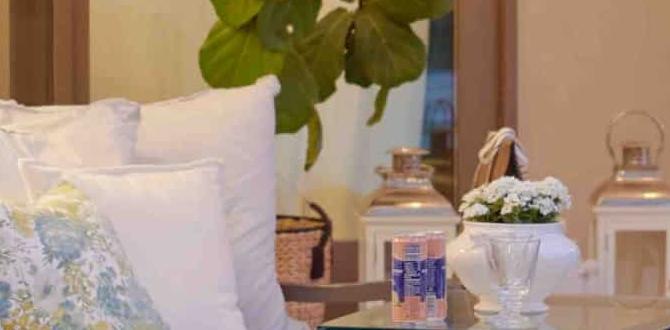Bolded Quick Summary (Top of Article)
Caring for daffodils indoors is surprisingly simple with the right approach. Provide cool temperatures, bright indirect light, and consistent moisture, avoiding overwatering. With these proven tips, you can enjoy their cheerful blooms indoors for weeks, bringing a touch of spring to your home. We’ll guide you through each step for success!
Hello there, fellow plant enthusiasts! It’s Pearl Roach from EcoPatchy, and I’m so excited to chat about a topic that brings a burst of sunshine even on the gloomiest days: indoor daffodils! Many of us adore these vibrant flowers, often picking them up from the store or receiving them as gifts during spring. The frustration often comes when we try to keep these cheerful blooms going, only to have them fade faster than we’d hoped. Is it possible to extend their indoor life and truly enjoy their beauty? Absolutely! You’ve come to the right place. This guide will provide you with proven, beginner-friendly tips to care for daffodils indoors, transforming your home into a blooming sanctuary. Get ready to learn how to keep those happy daffodil faces smiling for much longer!
Why Grow Daffodils Indoors? The Blooming Benefits
Bringing daffodils indoors is a delightful way to extend the feeling of spring, no matter the weather outside. They’re incredibly cheerful and can brighten up any room. Plus, they’re relatively low-maintenance once you understand their basic needs. For beginners, daffodils offer a rewarding indoor gardening experience. You get to witness the magic of a bulb transforming into a beautiful flower up close. It’s a fantastic way to connect with nature, especially if you live in an apartment or have limited outdoor space. Imagine a desk adorned with these sunny flowers, or a kitchen windowsill brought to life by their golden hues. The psychological boost from having live flowers indoors is undeniable, and daffodils are masters at delivering that bright, optimistic energy.
Understanding Daffodil Needs: The Indoor Edition
Daffodils, botanically known as Narcissus, are spring-blooming bulbs that signal the end of winter. In their natural outdoor habitat, they thrive in cool, moist conditions and need a period of winter chill to bloom. Replicating these conditions indoors is key to their success. They need a specific balance of light, temperature, and water to keep their blooms vibrant and their foliage healthy.
While they are often grown outdoors, with a little extra attention, you can create an indoor environment that mimics their preferred settings. Understanding their life cycle – from bulb to bloom and then to dormancy – is crucial for nurturing them properly. This isn’t about keeping them blooming endlessly indoors; it’s about enjoying their spectacular, yet fleeting, indoor display to its fullest. We’ll focus on how to provide them with the best possible environment after they’ve been forced for indoor blooming.
Getting Started: Choosing Your Indoor Daffodils
When you decide to bring daffodils indoors, you’ll usually find them sold as “forced bulbs.” These are bulbs that have been specially treated to bloom early, typically during the winter and early spring months. This means they’ve already gone through their cold period and are ready to grow and flower when brought into warmer conditions. Here’s what to look for:
- Healthy Bulbs: Look for firm, plump bulbs that are free from mold or soft spots. They should feel heavy for their size.
- Pre-Potted Blooms: Many garden centers sell daffodils already potted and showing signs of growth, often with buds forming. This is the easiest way for beginners to start.
- Variety: While classic yellow daffodils are popular, there are many varieties with different colors (white, orange, pinkish tones) and petal shapes. Choose what brings you joy!
If you’re starting with bulbs you’ve dug up from the garden after their dormancy or bulbs you’ve purchased that haven’t been forced, you might need to encourage them to bloom indoors. This usually involves a chilling period. Forcing bulbs typically involves placing them in a cool, dark place (around 35-45°F or 1.7-7.2°C) for 10-16 weeks, depending on the bulb type, before bringing them into a warmer spot to bloom. However, if you’ve bought pre-forced bulbs from a store, they are usually ready to go!
Proven Tips for Indoor Daffodil Care
Now, let’s dive into the tried-and-true methods for keeping your indoor daffodils happy and blooming. It’s all about providing the right environment. Think of it as giving them a cozy, temporary vacation in your home.
1. Light: Bright, But Not Too Hot
Daffodils, like most flowering plants, need light to thrive and bloom. However, direct, intense sunlight can scorch their petals and dry out the plant too quickly. The sweet spot is bright, indirect light.
- Ideal Location: Place your potted daffodils near a window that receives plenty of light throughout the day, but where the sun’s rays are filtered. An east or north-facing window is often perfect, or a south-facing window if it’s partially shaded.
- Rotate: Turn the pot every few days so all sides of the plant get exposure to light. This encourages even growth and prevents the plant from leaning drastically towards the window.
- Signs of Too Little Light: If your daffodil’s leaves are a pale green, leggy, or it fails to bloom, it might need more light.
- Signs of Too Much Light/Heat: Yellowing leaves or wilting flowers can indicate too much direct sun or heat.
2. Temperature: Cool is Key
This is perhaps one of the MOST critical factors for prolonging daffodil blooms indoors. Daffodils are cool-season plants. High indoor temperatures, common in heated homes, can drastically shorten their blooming period.
- Ideal Range: Aim for temperatures between 50-65°F (10-18°C). Cooler is generally better, so avoid placing them near heat vents, radiators, or sunny windows that get very warm.
- Cool Resting Spots: If you find your home is too warm, consider placing them in a cooler room overnight or in a basement if it’s not too cold and has some light. A cool windowsill in a rarely used room can also work.
- Post-Blooming: After the blooms fade, the plant still needs a cool period to recover and be ready for next season (though indoor recovery is different from outdoor).
3. Watering: Moisture, Not Muck
Daffodils need consistent moisture, but they absolutely hate sitting in soggy soil. Overwatering is a quick way to invite root rot, which is detrimental to the bulb.
- How to Check: Stick your finger about an inch into the soil. If it feels dry, it’s time to water. If it feels moist, hold off.
- Watering Technique: Water thoroughly until water drains from the bottom of the pot. Discard any excess water that collects in the saucer after about 30 minutes. This prevents the roots from sitting in standing water.
- Water Quality: If your tap water is heavily treated with chemicals, letting it sit out for 24 hours can help the chlorine dissipate, which is gentler on plants.
- Frequency: You’ll likely need to water more frequently when the plant is actively growing and blooming, especially if your home is warm. In cooler conditions, you’ll water less.
4. Soil and Potting
Most forced daffodils come in pots with a suitable potting mix. The key is good drainage.
- Drainage Holes: Ensure the pot has drainage holes. If your daffodils are in a decorative pot without holes, you can either keep them in their nursery pot and place that inside the decorative one (removing it to water and drain), or transplant them into a pot with drainage.
- Potting Mix: If repotting, use a well-draining potting mix. A standard indoor potting mix amended with perlite or sand works well. You can find excellent general-purpose potting mixes at most garden centers. For more on soil types, consider resources from The Old Farmer’s Almanac, which offers insights into soil composition suitable for various plants.
5. Fertilizing: Less is More
Daffodils store energy in their bulbs. Forcing bulbs are usually already prepared to bloom without additional fertilizer. Over-fertilizing can actually harm the plant or lead to weak growth.
- During Bloom: Generally, no fertilizer is needed while the daffodil is in bloom indoors if you purchased a pre-forced bulb.
- After Bloom: Once the blooms have finished, if you plan to try and over-winter the bulb and encourage it to bloom again next year (which is challenging indoors), you might use a diluted, balanced liquid fertilizer once or twice.
Troubleshooting Common Indoor Daffodil Problems
Even with the best intentions, sometimes issues pop up. Here are a few common ones and how to address them:
| Problem | Possible Cause | Solution |
|---|---|---|
| Yellowing Leaves |
|
|
| Flowers Fading Quickly |
|
|
| Drooping Stems/Flowers |
|
|
| No Blooms, Only Leaves (“Blind Bulb”) |
|
|
What to Do After the Blooms Fade
The blooms are beautiful but temporary. Don’t be disheartened when they fade! The plant has put all its energy into flowering. Now, it needs to focus on replenishing its bulb for potentially future blooms.
Option 1: Treat as a Annual (Easiest)
For most indoor gardeners, the simplest approach is to enjoy the daffodil for its flowering season and then discard the bulb. The bulbs used for forcing are often depleted, and it’s difficult to get them to reliably re-bloom indoors next year. You can compost the bulbs and foliage.
Option 2: Attempting to Over-Winter Indoors (More Advanced)
If you’re feeling ambitious, you can try to over-winter the bulb. This process is much more successful outdoors, but a determined indoor gardener can try. Here’s how:
- Cut Back Foliage: Once the blooms have completely faded, let the foliage continue to grow for another 4-6 weeks. Do not cut it back while it’s still green. The leaves are gathering energy to store in the bulb. Trim them off only when they turn yellow or brown and feel dry.
- Dormancy: After the foliage dies back, the bulb enters dormancy. Stop watering. If your pot is small and the soil dry, you can remove the bulb. Gently clean off excess soil.
- Cool and Dark Storage: Store the bulb in a cool, dark, and dry place. A paper bag or a mesh bag in a cool cupboard or even your refrigerator’s crisper drawer (ensure it’s not too cold, and no ethylene-producing fruits like apples are stored nearby) can work. The ideal temperature is around 40-50°F (4-10°C).
- Re-potting for Next Season: In late fall or early winter, re-pot the bulb in fresh, well-draining potting soil. Place it in a pot deep enough for the bulb to sit comfortably. Water it lightly.
- Chilling Period (Crucial for Re-blooming): The bulb will need another cold period. Keep it in a cool, dark location (like a cold garage, unheated porch, or even the refrigerator) for at least 10-13 weeks. This chilling period is essential for naturalizing and preparing for future blooms. You can find more details on bulb storage and chilling for next season at resources like the Royal Horticultural Society.
- Bringing to Bloom: After the chilling period, bring the pot into a bright, indirect light location and maintain cooler room temperatures (ideally 50-65°F / 10-18°C) to encourage new growth and eventual blooming.
Keep in mind that successfully re-blooming daffodils indoors year after year is challenging due to our consistently heated home environments and the specific light requirements for bulb replenishment. Outdoor over-wintering provides a much more stable and ideal cool season for the bulb.
When Should You Buy Indoor Daffodils?
The best time to purchase indoor daffodils is during their natural blooming season, which typically spans from late winter through early spring. This usually means you’ll see them available from around January through April, depending on your region and the varieties being sold.
- Early Season (January-February): You’ll find varieties that are more heavily “forced” to bloom earlier. These are perfect for beating the winter blues.
- Mid-Season (February-March): A wider selection of varieties becomes available.
- Late Season (March-April): You might snag some deals as the season winds down, but always check for the health of the bulbs and foliage.
Buying them when they are already showing buds or early flowers ensures you get the most enjoyment from your purchase. Avoid bulbs that are already fully open unless you plan to enjoy them for just a few days.
Frequently Asked Questions (FAQs)
Q1: Can I plant my indoor daffodils outside after they finish blooming?
Yes, you can! After the blooms fade and the foliage has yellowed and died back, you can plant the bulb in your garden. It may take a year or two to establish and bloom robustly outdoors, as it needs to recover and go through a natural cycle. Make sure to plant it in a well-draining spot, just as you would any other spring perennial.
Q2: My daffodil has long, floppy leaves but no flower. What’s wrong?
This usually happens if the bulb didn’t receive enough chilling time before being forced, or if it’s a variety that is prone to producing more foliage than flowers when grown indoors. It could also be due to insufficient light or extreme temperature fluctuations. Forcing bulbs is a specific process, and sometimes they miss a step. Ensure it has bright, indirect light and cooler temperatures to encourage better growth next time.
Q3: How long should I expect my indoor daffodils to bloom?
With optimal cool temperatures and bright, indirect light, you can typically expect your indoor daffodils to bloom for about 1-3 weeks. Factors like room temperature are the biggest influencers; warmer rooms will shorten the bloom time significantly. Enjoy them while they last!
Q4: Is it okay for my cat or dog to be around daffodils?
Be cautious! Daffodils are toxic to pets if ingested. All parts of the plant, especially the bulb, contain lycorine, which can cause vomiting, diarrhea, and other digestive upset. The nectar can also cause skin irritation. It’






